What Is the Fastest Way to Doing a Back Bend
How to Do Backbends in Yoga If You're Not Flexible (Yet)
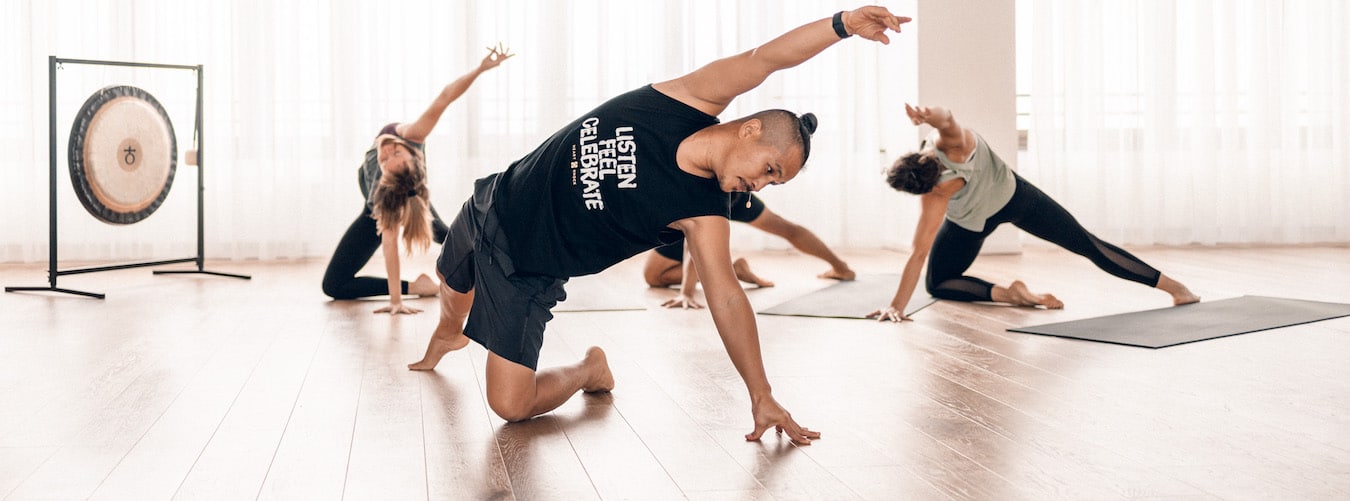
Most practitioners – whether advanced or beginners – experience it quite intense and somewhat scary to learn how to do backbends and have some kind of a love-hate relationship with backbending yoga postures.
This is only understandable since they can have great benefits when done properly, but can alsobear the risk of pain and injurywhen practiced without the right alignment.
While backbends strengthen the back muscles, stretch the front body and the shoulders and help you increase the flexibility of your spine, they can also compress the spine and put too much pressure on the lower spine, causing back pain. That's why it's so important to pay attention to the proper alignment when youlearn how to do backbends.
Plus, backbends make usmove in the opposite direction than we usually do: In our every-day lives, we often slouch forward in our chairs or on the couch or hunch over our smartphones or computers. Even if healthier sitting positions encourage us to keep the spine straight, we usually spend most of the time hunched forward. Backbends take us the opposite direction.
That's why it also is a good idea tostart with smaller backbends, such as Cobra or Sphinx, and gradually learn how to build up to backbends that are more advanced, like Full Wheel or Scorpion, for example.
"The body achieves what the mind believes."
1. 5 Steps to Prepare Your Body to Do Backbends
It may not be too obvious, but your ability to do backbends in yoga is not only determined by the flexibility of your spine. It's often tightness in the hip flexors, the shoulders, or the side body that compromises your form in yoga backbends.
Oftentimes, to compensate for this tightness, practitioners tend to put more weight onto the lumbar spine and overextend their back. This actually puts an immense amount of pressure on the vertebrae, pushing them closer together, which may, over time,cause inflammation.
If you want to learn how to do backbends – and do them in a safe and proper way – it's crucial to be aware of any possible safety issues backbends may cause. Therefore, it's not the best idea to directly go all in. You need to prepare your body first and start with some way more simple actions than backbending:
- Stretch your hip flexors.
- Mobilize your shoulders.
- Bend to the sides.
- Engage the back muscles.
- Stretch the sides of your body.
Before you attempt yoga backbends, do these preparatory poses towarm up the body for backbends.
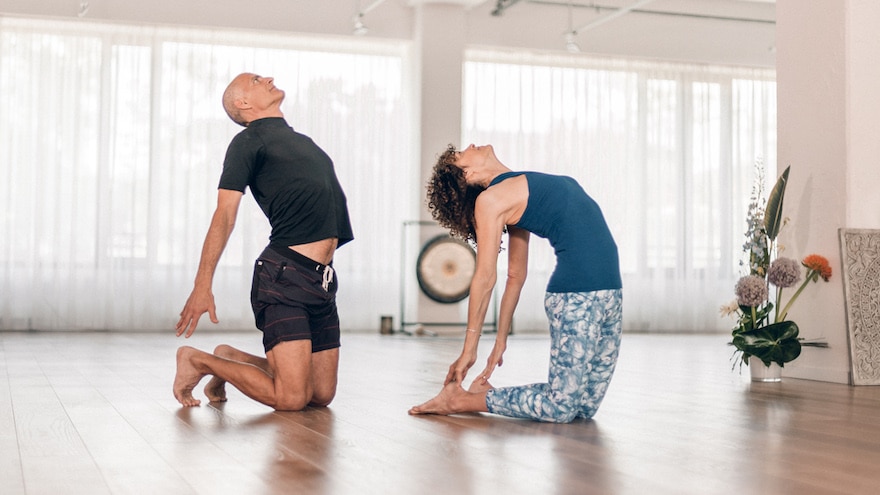
Prepare your body first before you attempt deeper backbends such as Camel pose. Photo: TINT Instructors Desirée Rumbaugh and Andrew Rivin
1.1. Stretch Your Hip Flexors
Start from Downward-Facing Dog and extend the right leg up into the sky. Rotate the thigh inwards and step the foot between your hands. Place the back knee down onto the yoga mat with a slight inward rotation of the thigh and the foot pointed. Place both hands onto the front thigh and push it away from you to create length in the front body.
Now, there are a few steps to remember:
- Push the pinky toe of the left foot firmly into the yoga mat.
- Move the left hip bone toward the right knee without twisting the knee or the shoulders.
- Push the right knee forward.
- Move the right sitting bone toward the right heel.
- Pull the pubic bone up. You'll now really feel your left hip flexor.
- Create length in the side body by lifting the shoulders up and slightly back.
- Raise the chin up and create length in the neck.
- Push the left foot further down until your left knee feels lighter so that you can lift it up.
- Elevate your heart up to the ceiling.
Maintain the pose for a few steady breaths and return to Downward-Facing Dog. Repeat the pose with the left leg in front to stretch the right hip flexor.
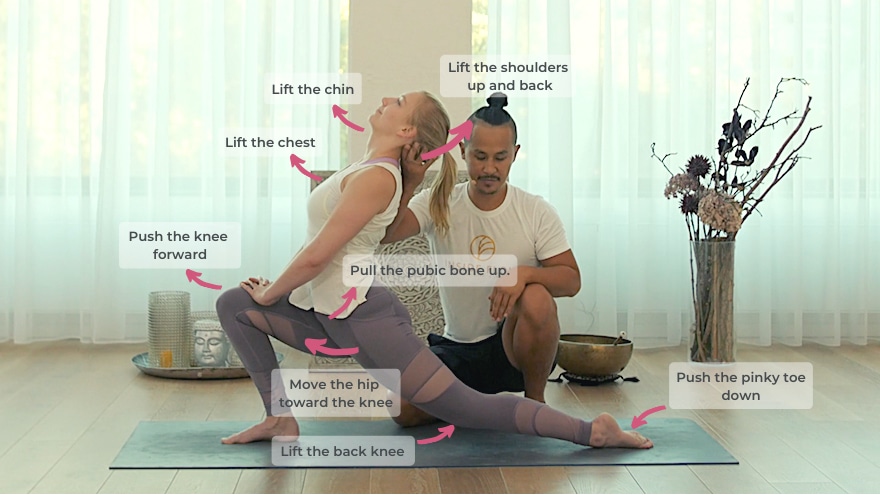
Start by stretching your hip flexors.
1.2. Mobilize Your Shoulders
Come into a table-top position with the hands under the shoulders and the toes tucked. To mobilize your shoulders to be ready to do a backbend, follow these 5 steps:
- Move your shoulders toward your ears to create length in the side body.
- Bring the arm bones into the socket to melt the chest down and soften the space between the shoulder blades.
- Outwardly rotate the arms.
- Move the bottom sides of the shoulder blades towards each other.
- Push the chest forward.
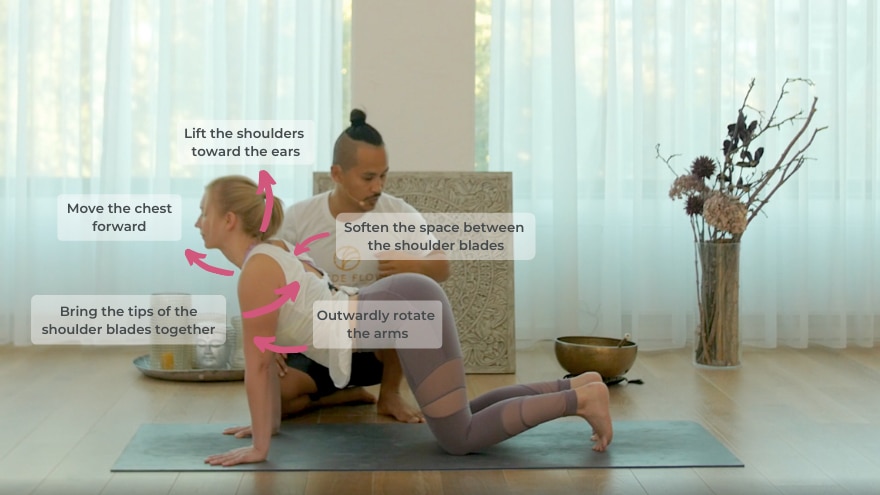
Mobilize your shoulders first before doing a backbend.
This is how you mobilize your shoulders in a safe way. You can apply these movements to any pose when you learn how to do backbends, for example in Downward-Facing Dog or High Lunge.
1.3. Bend to the Side
From Downward-Facing Dog, step the right leg between the hands and place the left knee on the ground. Start with bending the body to the sides to prepare for backbends:
- Lift the left arm up and place the hand onto the back of your head.
- Outwardly rotate your arm, i.e. move the elbow close to your head.
- Place the right hand onto the right thigh and push the thigh away from you.
- Start bending to the side by bringing the elbow further in toward your face.
- Lift the left shoulder up to create more length.
- Push the armpit back.
- To create a deeper side bend, push the elbow away from your body, i.e. up.
Return to Downward-Facing Dog and repeat the side bend to the left side by stepping the left foot between the hands.
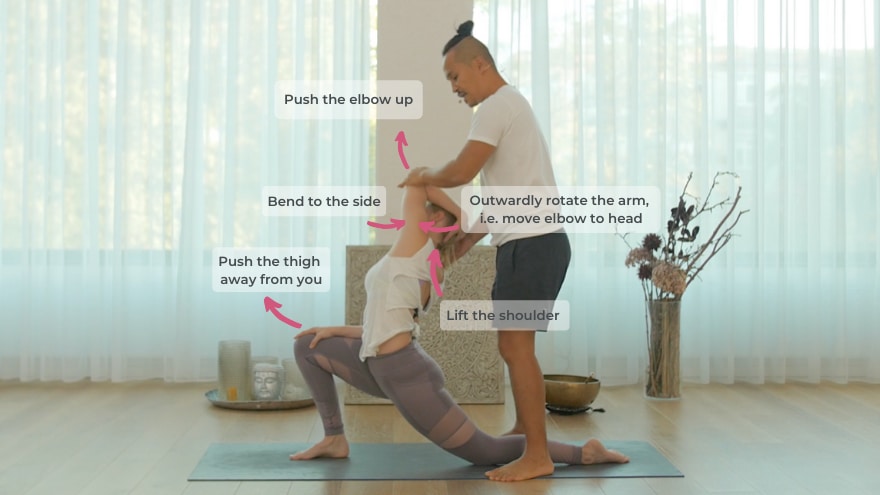
Bend to the side before bending back.
1.4. Engage Your Back Muscles
In order to do a backbend safely, it's crucial to properly engage the back muscles:
- Start in Chair pose and lift the arms up.
- Outwardly rotate the arms and bend them at a 90-degree angle.
- Bring the elbows slightly forward and the hands slightly back. Let the palms face forward.
- Lift the heels up to engage the back body.
- Imagine you're doing a pull-up: Push the elbows down and push the chest forward and up.
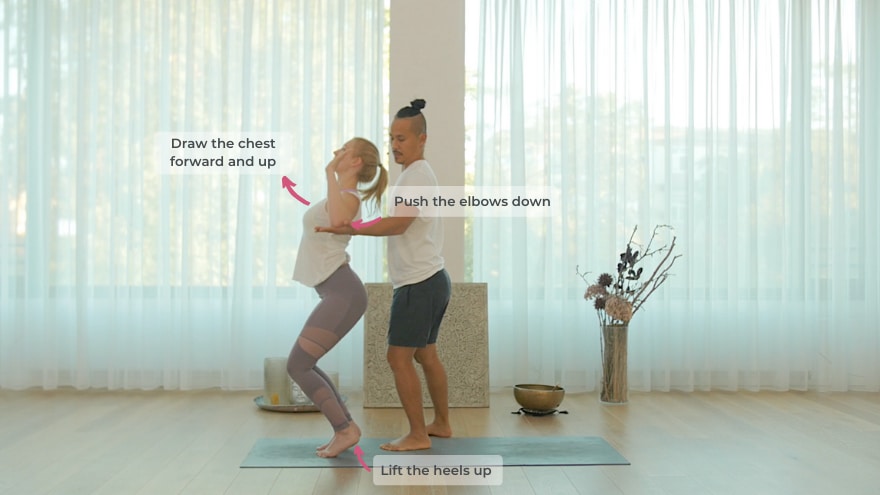
Engage the back muscles to make your backbends safe.
Maintain the pose for a few steady breaths. After that, you can do the same movements in a Low Lunge:
- Step one foot back and place the knee down.
- Pull the back knee and the front heel toward each other.
- Lift the pubic bone up and create length in the side body.
- Lift your arms up with an outward rotation.
- Bend the elbows and push them down while at the same time lifting the heart up.
- Keep breathing and let your breath guide you toward a deeper backbend.
- Change sides after a few breaths by stepping the opposite foot forward.
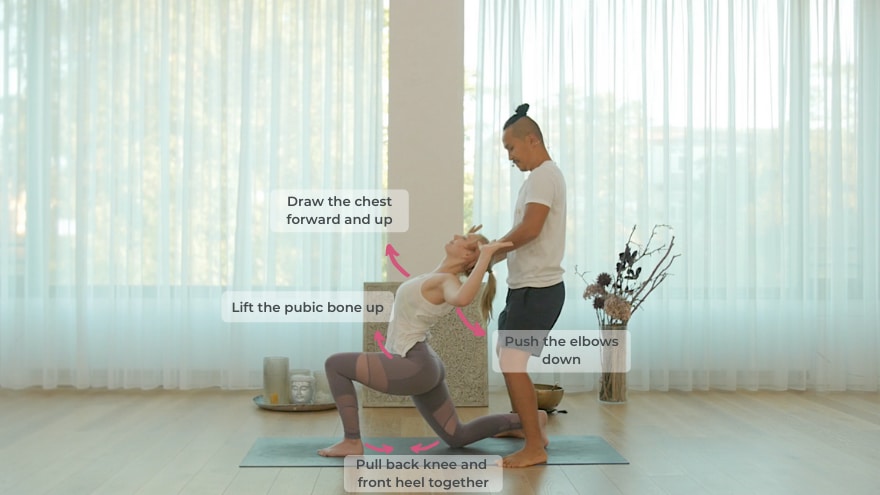
Target your back muscles for safe backbends in a Low Lunge position.
1.5. Stretch the Sides of Your Body
Stretching the sides of the body is essential when you learn how to do a backbend. To stretch the sides of the body:
- Come to Downward-Facing Dog.
- Let the heels drop to the right side.
- Push the buttocks backward to create a side stretch on the left side of the body.
- Energetically push the left hand away from you and into the yoga mat to intensify the side stretch.
Stay here for a few breaths before you drop your heels to the left side and stretch the right side of the body.

Stretching the sides of the body makes backbends more accessible.
Remember thesefive actions in every yoga backbend you do. They're essential to keeping your spine safe and healthy. Apart from that, they will not only help you to approach safer backbends but also to experience deeper backbends in yoga.
If you're looking for advice on safe and healthy alignment in any yoga pose, including yoga backbends, the flexible content on TINT helps you maintain a safe and healthy yoga practice in general, not just when doing backbends. Start your journey to backbends now with our 14-day free trial.

GET YOUR FREE EBOOK NOW!
Use it as a reference guide to make the most of your yoga practice or teaching.
- 34 pages
- Standing Poses, Backbends, Arm Support Poses
- Bonus: Warm-up- and Cool-down-Session
2. 5 Yoga Backbends You Can Do Right Away
Now that you've learnedhow to do backends in general, it's time to look at individual backbends in more detail. But remember: Even though strong yoga backbends like Full Wheel may look very impressive and earn you a bigger amount of likes on Instagram, start with smaller backbends in yoga to familiarize yourself and your body with the action of bending your spine backward. With patience and persistent practice, the more advanced backbending poses will naturally become accessible to you.
2.1. Chair (Utkatasana)
Yes, Chair pose is (also) a backbend. It's not only your thighs that have to work hard in this pose, but your lower back muscles are equally engaged.
With the feet hip-width apart, bend the knees and lower the hips down. Imagine you want to sit on a chair behind you. Lift the arms up overhead with the palms facing and lift the chest to create a gentle backbend.
Push the big toes down into the mat and inwardly rotate the thighs while keeping the knees above the ankles. This helps you to engage the legs.
The slight curve in the lower spine will stretch out the front body. Shifting the bodyweight further back and tilting the pelvis forward will make the backbend more pronounced.
Note that Chair pose is a slight backbend for the lower back, it's not a backbend for the head and neck. Although there's a slight curve in the neck, the head shouldn't drop backward. Instead, lift the chin up slightly.
In this short video, Young Ho Kim guides you step by step through the correct alignment in Chair pose.
Learn Chair pose in Young Ho Kim's Inside Yoga Alignment on TINT.
Avoiding back pain in backbends is not only a question of flexibility, but rather of the correct technique. Since a proper and healthy technique is essential to any yoga pose, TINT offers you a diverse amount of content on flexibility & mobility, such as Alexey Gaevskij's Functional Body, to make your yoga practice safe and efficient and to improve your technique when doing backbends. Give it a try now and get 14 days for free.

GET YOUR FREE EBOOK NOW!
Use it as a reference guide to make the most of your yoga practice or teaching.
- 34 pages
- Standing Poses, Backbends, Arm Support Poses
- Bonus: Warm-up- and Cool-down-Session
2.2. Cobra (Bhujangasana)
Cobra pose may the first asana you think of when you think of yoga backbends. It's a pose that is accessible to beginners and it's a perfect counteraction to stretch the front of the body. However, even if Cobra pose is a smaller backbend, it's still important to pay attention to the correct alignment in order to avoid back pain.
Start in a prone position with the legs straight and the feet hip-width apart. Place the palms on the ground next to the rib cage and keep the forearms are vertical. Let the index fingers point straight forward so that the arms are in an outward rotation.
Lift the chest and lengthen through the upper back. Move the shoulders back and move the tips of shoulder blades towards each other. When lifting up the chin, avoid hyperextending the neck.
Practice Cobra pose together with Desirée Rumbaugh and Andrew Rivin in this short video:
Learn Cobra pose in Buidling Blocks for a Transformational Home Practice on TINT.
2.3. Camel (Ustrasana)
Approaching the deeper yoga backbends, Camel pose does not only strengthen the body, but also the mind. It's one of the yoga poses where you have to distinguish between the feeling of muscular engagement and actual back pain.
To enter the pose, kneel on the knees and keep them hip-width apart while outwardly rotating the thighs.
Before reaching the hands down for your heels, lift the chest up and push the buttocks forward. Move the shoulders up and back and try to bring the tips of the shoulder blades towards each other. When reaching for the heels, make sure the arms are outwardly rotated, i.e. the thumbs are on the outsides of the feet while the fingers are on the insides.
Engage the leg muscles by imagining that you want to straighten the legs. It's also easier to activate the leg muscles when the toes are tucked so that you can push the toes into the yoga mat.
Now it's time to roll out the yoga mat and watch this short video where Young Ho Kim takes you step by step through Camel pose.
Lern Camel pose step by step in our Inside Yoga Alignment on TINT.
2.4. Wild Thing (Camatkarasana)
Wild Thing, which is also called Rock Star or Flip Dog, is a deeper yoga backbend that will give you strength and confidence. It's a strong yoga pose said to energize the body and promote blood circulation.
To get into the pose, start sitting on the yoga mat straightening one leg out in front and bending the other one with the foot on the floor. Place the hand of the straight-leg side on the mat behind the buttocks. Keep the back arm in an outward rotation when you lift the buttocks up. Lift the hip further up by pushing the straight leg's foot firmly into the yoga mat and push the mat away with the hand.
Engage the back muscles by placing the other hand onto the back of your head and pushing the head against the hand.
For the full expression of the yoga pose, straighten the arm again and bring it into an outward rotation as well, maybe even touching the ground.
Lern how do a backbend in Wild Thing in our Inside Yoga Alignment on TINT.
Since this yoga pose is also said to open your heart chakra (the 4th chakra), you should definitely not miss Faith Hunter's Chakra Awakening Body & Soul.
2.5. Full Wheel (Urdhva Dhanurasana)
Full Wheel belongs to the more advanced yoga backbends and is both demanding and invigorating. The deep backbend opens up the chest but also requires a lot of strength and stamina.
To approach Full Wheel, start in a supine position. Place the palms next to the ears and let the fingers point toward the shoulders. Firmly ground the feet into the yoga mat and inwardly rotate the thighs. Push the hips up and create a strong arch along the entire spine.
You can practice Wheel pose for example with Barbra Noh in her Strength & Grace Yoga on TINT.
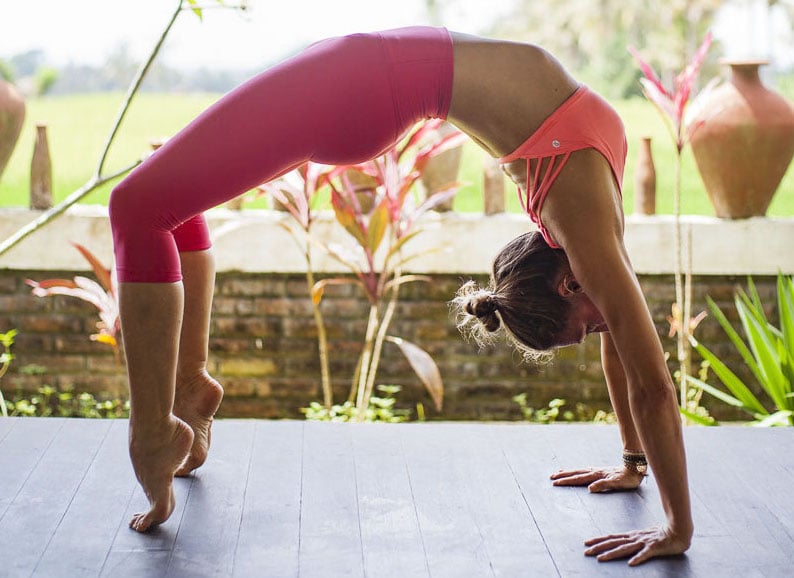
Full Wheel pose is a strong backbend. Photo: TINT Instructor Barbra Noh.
Prepare your body with the Warm Up for Backbends from our Inside Yoga Alignment or explore the movements of the Cat Spine and the Cow Spine with Desirée Rumbaugh in Strong & Mindful Yoga.
These classes are meant to be used for the purpose of taking time to work intensively with your body or with the bodies of your students. Rather than flowing, like many yoga classes, this work is slow and static giving the user more time to breathe, feel and understand and notice the details of the work.
Put your newly gained knowledge on how to do backbends into practice and feel the difference in yoga backbends like Cobra, Camel, or Wheel yourself, check out one (or several) of our numerous backbending programs on TINT.
When you're ready to take your backbends one step further, practice, for example, backbends with Finlay Wilson or learn how to Master Your Backends with Mathieu Bouldron. Make sure you also check out Barbra Noh's Bamboo Backbends. There's no more reason to be afraid of learning how to do backbends! And with TINT Yoga, you have the option to try it 14 days for free.

GET YOUR FREE EBOOK NOW!
Use it as a reference guide to make the most of your yoga practice or teaching.
- 34 pages
- Standing Poses, Backbends, Arm Support Poses
- Bonus: Warm-up- and Cool-down-Session
Learn from the world's greatest yoga minds

What Is the Fastest Way to Doing a Back Bend
Source: https://tintyoga.com/magazine/how-to-do-backbends-in-yoga-if-youre-not-flexible-yet/